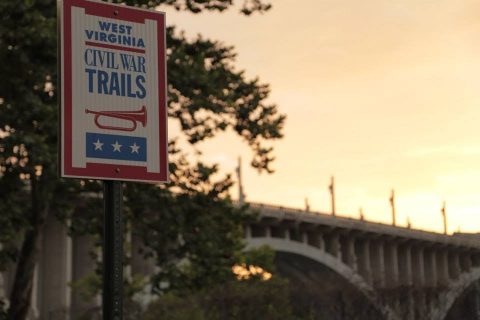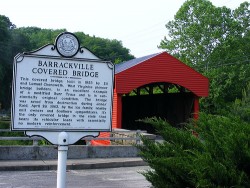Marching Along Marion County’s Historical Past
September 12, 2016
If you listen closely, you can almost hear the faint beat of a Civil War snare drum echoing across the rolling hills of Marion County.
At first glance, it might be hard to imagine that our neighborhood was once a part of an era that redefined us as a nation, but if you explore Fairmont and its surrounding communities, you will soon feel a historical presence that is still alive today.
Many times we get caught up in the big picture of our past, forgetting about the richness within the smaller details of historical events.
Walk along the same paths and roads that Union and Confederate soldiers once traveled. Take a self-guided tour of Marion County Civil War markers (maps available at the Visitor Center).
Attack on Fairmont (foot of the former Low-Level Bridge -Madison St., Fairmont) – On April 29, 1863, Confederate troops under General William Jones captured the town of Fairmont and tried to destroy the Baltimore and Ohio Railroad bridge upstream at present-day 12th Street. You can still see some of the bullet-pocked bridge piers on the (Monongahela River) riverbanks.
The home of A. B. Fleming (220 Jefferson St., Fairmont) – Aretas Brooks Fleming was the 8th Governor of West Virginia. During the war, he was the Marion County prosecuting attorney and served in the Fairmont Home Guard. The marker is located on the grounds of the former American Legion Home.
Battle for the Bridge (Palatine Park – Everst Dr., Fairmont) – At the site of the Palatine foundry, a battle of the suspension bridge took place on April 29, 1863. The bridge spanned the Monongahela River between Fairmont and Palatine.
The Beverly -Fairmont Turnpike (117 Benoni Ave., Fairmont) – The Beverly-Fairmont Turnpike was completed in 1852, and gave access to the new railroad, which had reached Grafton that same year. Beverly continued to be the county’s center of commerce until the 1890’s.
Francis H. Pierpont Home (366 Quincy St., Fairmont) – Governor of the Restored Government of Virginia brought his bride, Julia Augusta Robertson Pierpont here in 1854. Pierpont devised plans that restored loyal Virginia to the Union and gave life to West Virginia. Julia is credited for honoring soldiers from both sides of the war on Decoration Day. Now known as Memorial Day.
Woodlawn Cemetery (335 Maple Ave., Fairmont) – Boaz Fleming, the founder of Fairmont, is here with his wife, Elizabeth. Another descendant is Aretas B. Fleming, eighth governor of West Virginia and a founder of Fairmont. James Otis Watson is considered the father of the bituminous coal industry in north-central West Virginia. He and Pierpont owned the first coal mine to be commercially viable following the completion of the Baltimore and Ohio Railroad linking Fairmont with the eastern seaboard markets. One of his daughters married Aretas B. Fleming. His sons, James Edwin Watson, Sylvanus Lamb Watson, and Clarence Wayland Watson are also buried here. Matthew Mansfield Neely, a governor, a congressman, and a national senator is also buried in the cemetery. This is also the final resting place for Francis Pierpont, his wife, Julia, and three of their four children.
 Although not officially part of the Civil War Trails, at this time, the Barrackville Covered Bridge (off U.S. Route 250 N, County Route 21 at the junction of 250/32) – was saved from destruction during the Jones-Imboden Raid (preliminary to the Battle of Fairmont). During the raid, the Ice Family, nearby mill owners, and Confederate sympathizers convinced General William ‘Grumble’ Jones to save the bridge. The bridge was originally built in 1853 by Eli and Lemuel Chenoweth.
Although not officially part of the Civil War Trails, at this time, the Barrackville Covered Bridge (off U.S. Route 250 N, County Route 21 at the junction of 250/32) – was saved from destruction during the Jones-Imboden Raid (preliminary to the Battle of Fairmont). During the raid, the Ice Family, nearby mill owners, and Confederate sympathizers convinced General William ‘Grumble’ Jones to save the bridge. The bridge was originally built in 1853 by Eli and Lemuel Chenoweth.
Which of these Marion County historic sites have you visited?


